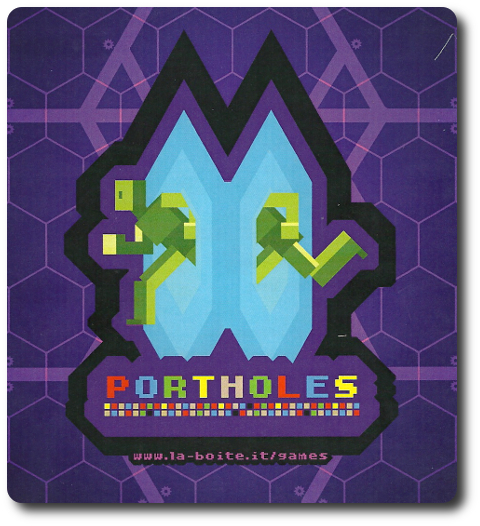
The Basics:
- For ages 8 and up (publisher suggests 12+)
- For 2 to 5 players
- Approximately 60 minutest to complete
Geek Skills:
- Active Listening & Communication
- Counting & Math
- Logical & Critical Decision Making
- Reading
- Risk vs. Reward
- Cooperative & Team Play
- Hand/Resource Management
Learning Curve:
- Child – Easy
- Adult – Easy
Theme & Narrative:
- Escape the prison before the guards get you!
Endorsements:
- Gamer Geek rejected!
- Parent Geek mixed!
- Child Geek mixed!
Overview
When the fully automated prison was opened, its governing AI was hailed as the greatest thing ever created. That was over 100 years ago. The AI, KAL 9000, is now old and slow. The prison population has been cut back to reduce the amount of demand on the AI, but it’s still being taxed. After it’s latest update, KAL 9000 divided by zero and decide that the most logical thing to do was to blow up the prison. As an inmate of LUNA-2, you have this one chance to get out before everything explodes.
Portholes, designed by Gaetano Leonardi and published via the Game Crafter, is comprised of 1 “Left Side” game sheet, 1 “Right Side” game sheet, 1 Deck game sheet, 9 “Item” Health tiles, 8 “Guard” Health tiles, 4 “Prisoner” Health tiles, 1 Arrow tile, 4 Furniture tiles, 2 “Red” Portal tiles, 12 Portal tiles (in 6 different colors), 11 “Guard” Action cards, 15 “Prisoner” Action cards, 24 Item cards, 4 Prisoner Hero cards, 12 miniatures (4 Prisoners and 8 Guards), 1 standard six-sided die, and 1 custom six-sided Combat die. The tiles are made of thick cardboard and durable. The game sheets are made of cardstock and are not. The 12 miniatures are small and made of plastic. The artwork by Gaetano Leonardi is excellent. Everything is brightly illustrated and heavily influence by the 8-bit video game era.
Game Set Up
Before setting up the game, I suggest you photocopy the back of one of the game boards. The “Right Side”, “Left Side” and Deck game sheets all have the same instructions that describe how to set up the game. Unfortunately, the rule book does not and the first step of the game set up is to place the game sheets down so you can no longer read the instructions on their back. However, to be fair, the Deck game sheet is required towards the end of the game set up process, allowing players to continue the game set up with little difficulty. Still, you’ll be placing it down when there are still instructions left to follow.
To set up the game, first unfold and place the “Left Side” and “Right Side” game sheets so they are connected in the middle of the gaming area. The instructions refer to these as “boards”, but they are not thick enough to qualifies as a “board”, in my opinion.
Second, grab the 4 Furniture tiles and roll the six-sided die once per tile. The number rolled identifies which of the 6 rooms the Furniture tile is placed. If a number is rolled for a room where a Furniture tile is already located, roll again. Repeat until all 4 Furniture tiles are on the game sheet.
Third, grab the 12 Portal tiles (not the “Red” Portal tiles), and place each on a matching colored gear. Orientate the Portal tiles so they are in the “open” position. An “Open” Portal tile will show the two arrows pointing into the room and pointing out into the main area. Each of the 12 rooms (4 of which will have a Furniture tile) will have 2 Portal tiles.
Fourth, take the six-sided die and roll once for each of the “Red” Portal tiles. In the middle of the game sheet is a large red hexagon room. On each of the six walls of the middle room is a number. Match the number rolled on the die with a room wall and place a “Red” Portal in the “closed” position. If a number is rolled for a wall where a “Red” Portal tile is already located, roll again.
Fifth, unfold and place the Deck game sheet off to one side of the game playing area (or connect it to the larger game sheet in the middle of the playing area).
Sixth, shuffle the Item cards and deal out 4 piles of 6 Item cards each. Place 1 pile face-down on each of the 4 spaces on the Deck game sheet that match the 4 Furniture tiles.
Seventh, shuffle the “Guard” and “Prisoner” Action cards into separate piles and place each face-down on their reserved space on the Deck game sheet. Now is a good time to note that cards that are discarded should be placed face-up next to their matching draw pile. A helpful illustrated arrow with a trash can icon is on the Deck sheet to help players keep their game organized.
Eighth, depending on the number of players in the game, the miniatures and other tiles will now be organized. One player MUST play as the guards. This player takes all the Guard miniatures and “Guard” Health tokens, setting them in front of their sitting position. The other player or players will take the “Item” Health tokens, the “Prisoner” Health tokens, and the Prisoner Hero cards, setting them in front of their sitting position.
Depending on the number of other players who are not assigned to the guards, divide up the Prisoners as follows:
- 1 player takes all the Prisoners
- 2 players split the Prisoners (2 Prisoners each)
- 3 players each get 1 Prisoner each, with 1 player receiving a second prisoner
- 4 players each get 1 Prisoner each
Ninth, each player who has a Prisoner takes their Prisoner Hero card, matching Prisoner miniature, and matching “Prisoner” Health tile. Each player with a Prisoner now rolls the six-sided die and places their Prisoner miniature in 1 of the 6 rooms in the same way they placed the 4 Furniture tiles. Only 1 Prisoner per room is allowed.
That’s it for game set up. Time to fight for your freedom.
Quick Notes on Card Interaction
There are a number of cards in the game that deserve a brief explanation. These cards can be found by the players and stolen as the game progresses. They are tools meant help the prisoner’s survive and are a means of escape. The cards also break and bend the rules that all players must follow during the game. Where applicable, cards always trump the rules of the game.
Prisoner Hero Cards
Each Prisoner Hero card details the basic stats of the associated miniature. Everything a player needs to know is shown and summarized. Prisoner Hero cards also act something like a character sheet and keep track of health and what equipment the prisoner has access to.
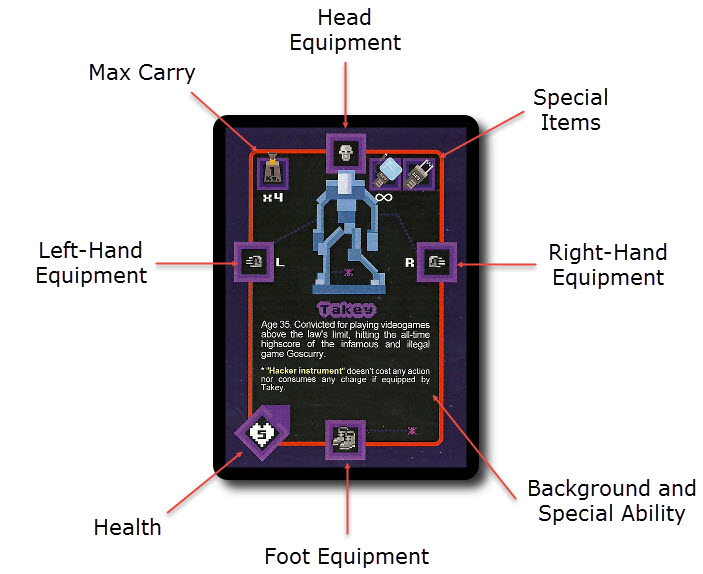
- Max Carry lists how much total weight the prisoner can hold. Equipped items all weigh something and the player will not be able to equip their prisoner if they are carrying too much.
- Head, Right-Hand, Foot, and Left-Hand Equipment symbols are used to attach Item cards the player wants to equip to their prisoner.
- Special Items lists specific equipment that is most useful in this prisoner’s hands.
- Background and Special Ability give the player an introduction to their prisoner and describes a special ability the prisoner can use or benefits from.
- Health lists the starting life of the prisoner. As the game continues, the prisoner might have their health reduced. If they reach zero, they are out of the game.
“Prisoner” Item Cards
“Prisoner” Item cards can be found by searching the Furniture tiles. Hidden within them are weapons, tools, armor, and the necessary items to leave the prison.
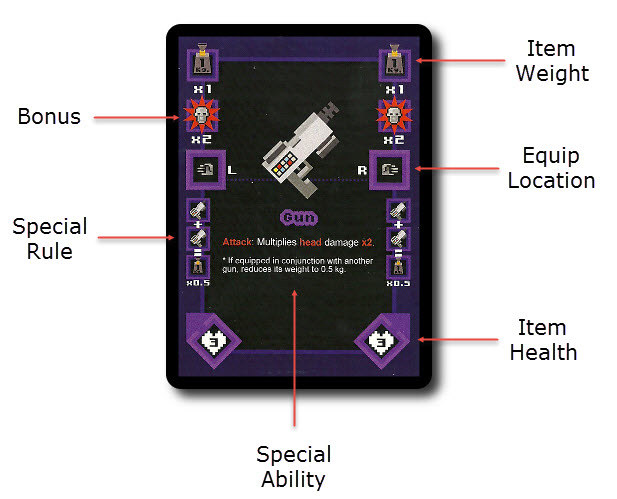
Not all items are weapons, but we’ll use one as an example.
- Item Weight is used to determine if the Prisoner player can hold the item they are carrying.
- Equip Location shows where an Item card can be equipped. In the case of the “Gun”, it can be equipped on the Right-Hand or the Left-Hand location. When equipping an item, the Equip Location must be free. If it is, the Item card is slipped underneath the Prisoner Hero card so only the sides of the Item card are showing.
- Item Health is used to keep track of the item’s durability. When an item is used, its Item Health is reduced. When it drops to zero, it becomes junk. Most of the time, junk is best thrown, but there are cards that allow players to fix junked items.
- Special Abilities list any unique rules that apply to item or the prisoner who uses it.
- Special Rule and Bonus describe what the item does.
“Prisoner” Action Cards
Along with the actions that each Prisoner player has access to, the “Prisoner” Action cards provide special abilities and ways to subtly bend the rules. Some are special items, bonuses to actions, or new actions. Explained here is one of the more useful “Prisoner” Action cards, as it allows the Prisoner player to retrieve stolen items taken by the guards.
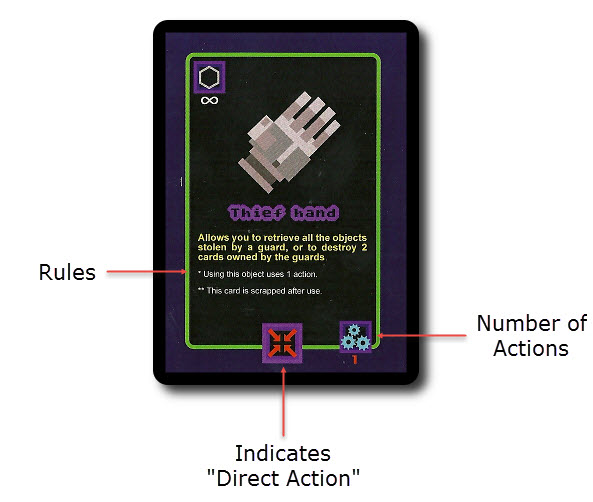
- Number of Actions lists the number of actions it takes to use the card.
- The icon indicates “Direct Action”.
- Rules are provided on the card that summarizes how it’s used.
“Guard” Action Cards
The Guard player has a number of tricks up his sleeve, as well. Like the Prison players, the Guard player is provided a special Action card that can be used to get the upper hand. The “Guard” Action cards contain special actions, items, and other tools that prison guards would want to have available to them. Explained here is one such time.
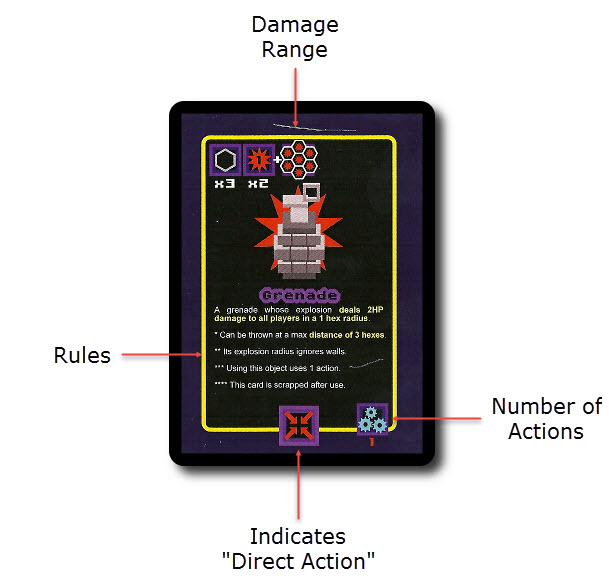
- Damage Range indicates how many miniatures within the blast radios shown will take damage.
- Number of Actions lists the number of actions it takes to use the card.
- The icon indicates “Direct Action”.
- Rules are provided on the card that summarizes how it’s used.
Running and Gunning
Portholes is played in rounds with each player taking 1 turn per round. Rounds always start with the Prisoner player sitting left of the player controlling the Guards and ends with the player who is controlling the Guards. The players who are playing as the Prisoners are collectively referred to as the “Convict Team”. A round of game play is summarized here.
Convict Team Phase
At the start of the Convict Team phase, and only occurring once per round, the LUNA-2 AI computer will randomly activate a Portal. This Portal will shift to an “open” or “closed” position. This is referred to as “toggling” the Portal. Any player takes the six-sided die (preferably a Prisoner player so they feel like they have some semblance of control over the outcome) and rolls it. The number rolled identifies 1 of the 6 outer rooms (never the middle room). The Convict Team chooses 1 of the 2 doors and toggles it “open” or “closed”.
Then, before any Prisoner player takes their team, the Convict Team draws 2 “Prisoner” Action cards. If the deck runes out, shuffle any discarded “Prisoner” Action cards to make a new deck.
Each Prisoner player can now take 1 action, starting with the Prisoner player directly left of the Guard player. Each action is summarized here.
Move
If the Prisoner player wants to move their Prisoner miniature, they take the six-sided die, roll it, and can then move a number of hex spaces equal to the number rolled on the die. A player can never move any more hex spaces than the number rolled (unless otherwise trumped by card), but nor are they forced to move the maximum.
Miniatures cannot move through a wall, closed Portals, and other miniatures. However, miniatures can end their movement on a hex space that has another miniature on it IF that hex space is divided by a wall or a closed Portal. This acts as a dividing line that separates the two miniatures.
Search
Scattered around are useful pieces of equipment and items required to escape. Unfortunately for the Prisoner players, they have no idea where they are (nor does the Guard player, for that matter). This means each Prisoner player will need to search and the only places to look at the 4 Furniture tiles.
If the Prisoner player’s miniature is located in the same or adjacent hex space as a Furniture tile, they may search it. Searching is automatically successful and allows the player to draw 1 Item card from the card space on the Deck game sheet that matches the Furniture tile. Any items found can be immediately equipped, but each Prisoner player’s hero can only carry so much weight. If need be, discard cards to compensate for the newly discovered item’s weight.
Exchange
If 2 Prisoner miniatures are adjacent to each other, they may exchange cards. Any number of cards can be exchanged and equipped for free when given.
Equip
Unless an item is equipped when it’s found or when it’s exchanged, it will cost the player 1 action to equip their item.
Interact
Scattered about the prison are controls to open Portals of specific doors. Prisoner players adjacent to these controls can toggle a Portal “open” or “closed”. A useful trick to trap Guards and free teammates.
Use
Any member on the Convict Team can use a “Prisoner” Action” card. The card is selected and its effects are resolved. The card is then discarded.
Attack
Combat can be triggered when two miniatures are adjacent to each other. Combat is lethal in Portholes and is something like Thunderdome. Once 2 miniatures start in combat, only 1 of the 2 miniatures is going to walk away. As such, Prisoner players should consider the odds of their survival before they go running towards a Guard miniature with nothing more than their fists.
Combat is played out with the attacker rolling the Combat die. The Combat die has a symbol for the head, feet, chest, left hand, and right hand of the target being attacked. After the attacker rolls the die, the defender takes the same die and rolls it. For the most part, that is it. Equipped weapons can give an attacker a significant advantage.
- If the defender’s roll matches the attacker’s roll, the attack failed.
- If the defender’s roll DOES NOT match the attacker’s roll, the attack succeeded!
Health is kept track of using the Health tokens. All Guards and Prisoners start with their max. When they take a point of damage, the Health token is rotated so the next lowest number is showing. For the Prisoner player, their “Prisoner” Health token is placed in the middle of their Prisoner Hero card and the lower left Health value indicates the starting health and the arrow points to the Health token value currently being used. The Guard player uses a special space on the Deck game sheet to keep track of the Guard’s health, but the use of the Health tokens is the same.
After the attacker has had a chance to hit their target, the defender becomes the new attacker and rolls the Combat die. This continues, with Health being reduced, until 1 of the 2 miniatures has their Health reduced to zero.
If a Prisoner player’s miniature falls in combat, they are no longer in the game. All Item cards the Prisoner had are taken by the Guard player and attached to the Guard miniature. Killing this Guard miniature will allow another Prisoner player to collect the Item cards, but only if they have the “Thief Hand” card.
If a Guard player’s miniature falls, it’s removed from the game sheet.
Continuing the Phase
The Convict phase continues with each Prisoner player taking their turn and completing an action. After all the Prisoner players have had a turn, the Convict Team can only keep a number of “Prisoner” Action cards equal to the number of Prisoner miniatures still on the game sheet. The Convict team can decide which cards to keep and which cards to discard.
Guard Phase
The Guard player now has a chance to retaliate.
At the start of every Guard phase, the Guard player can add Guard miniatures to the game sheet. The Guard player rolls a six-sided die and subtracts the number of Guard miniatures currently in play from the number rolled. The resulting number, if positive, is the number of Guard miniatures the Guard player can deploy.
The guards to be deployed is decided at random. The “Guard” Health tokens are randomized and a number of “Guard” Health tiles are drawn equal to the number of guards to be deployed. These “Guard” Health tokens are placed on the designated space on the Deck game sheet. The Guard miniature is them placed on the game sheet in the space that has an image representing the guard. Then the Guard player draws 1 “Guard” Action card.
The Guard player can now take 1 action with each of their deployed Guard miniatures, too. The Guard player does not get to take all the same actions as the Prisoner players, however. Those that are available are in included here, along with any notes the summarizes subtle differences.
- Move
- Use (using only “Guard” Action cards)
- Attack
After the Guard player ends their turn, the round is completed. A new round now begins with the Prisoner player directly to the left of the Guard player.
Winning the Game
The Guard player wins the game if they can eliminate all for of the Prisoner players from the game.
The Convict Team wins if they can complete the following:

- Find the “Red Key” to open a “Red” Portal, granting access to the middle room
- Find the “KAL 9000” and spend 1 action to reactive it in the middle room
- Find the “Power Cell” and spend 1 action to place it to the escape pod in the middle room
- Spend 1 action to ignite the engines in the middle room.
After the Convict Team completes the list, the entire team wins, but technically speaking, only those Prisoner miniatures in the middle room are leaving the prison. Regardless of location or playing status, all the Prisoner players share in the victory.
To learn more about Portals, visit the game’s web page.
Final Word
The Child Geeks very much enjoyed themselves at first. As the game continued, their level of enthusiasm started to drop. According to one Child Geek, “I feel too restricted in the game. I want to move over to that side of the game board, but I keep rolling 1’s and 2’s. How can I help my team if I can’t even move?” The same was said by a Child Geek who was playing as the Guards. She said, “My guards are all fat and stupid. The don’t move fast and cannot attack. No wonder the prison is exploding.” All the Child Geeks liked the way health was kept track of and found the game very visually appealing. The thrill of finding useful items and keeping hush-hush about finding the necessary items to win the game gave them a giddy little thrill. The older Child Geeks appreciated that they couldn’t carry everything due to its weight, but they found their prisoners to be fairly inept at breaking out. As one Child Geek put it, “I am playing as the most incompetent convict in the history of the everything.” When it came time to vote, the Child Geeks were split. For those who found the game more frustrating than entertaining, they gave Portals a thumbs down. For those Child Geeks who were able to escape or put down every prisoner, they gave the game a big thumbs up.

The two “Prisoner” Brothers think and discuss what they should do next…
The Parent Geeks were not nearly as impressed as the Child Geeks, but they had just as much fun. According to one Parent Geek, “I like playing this game against my kids. I take the role of the guards and I let my family take on the role of the convicts. It creates for some interesting moments.” It also created a few tears. Overall, the Parent Geeks found Portholes to be a game full of options, but lacking ability. One Parent Geek said, “I know what I want to do and what I need to do, but I’m stuck because I either can’t find what I need or can’t move fast enough to get where I need to go.” The combat system was also found to be clunky. This was especially true when 1 Guard happened to take out 2 Prisoner players. “Horrible”, is how one Parent Geek put it. When it came time to vote for the game, those Parent Geeks who were entertained voted to approve it. Everyone else voted to rejected it. The end result was a mixed endorsement overall from the Parent Geeks.
The Gamer Geeks didn’t care for Portholes. As one Gamer Geek put it, “This game has all the right ideas, but it never feels like it’s streamlined or well-organized enough to get it right.” All the Gamer Geeks found the “roll-and-move” game mechanic to be absolutely ridiculous, the single action per turn to be way too limiting, and lack of details on certain rules to be frustrating. according to one Gamer Geek, “Is there a certain sequence my team is required to use to get out of prison? I don’t know and nor does the rules, apparently.” But it was not all doom and gloom. The Gamer Geeks found a number of things they rather liked about the game. For examples, they all liked the artwork, the way you could boost a character to make them more effective in combat, and how the Portal tiles were always shifting. But what they liked was outweighed by the Gamer Geek’s lack of patience and exasperation. “Uh, wasn’t there supposed to be an auto-destruct in this game? When exactly does this prison blow up, anyway?”, asked one Gamer Geek. Never. The end result was no explosion and the gaming elitists rejecting Portholes.
I found Portholes to be a mix of entertainment and frustration. I’m not big on games that limit what a player can do. Doing so only reduces depth of play. I would have found the game much more interesting if each player was given so many action points to spend on their turn. Using those, they could do any of the actions any number of times as long as they had points to spend. Want to move 3 spaces? Sure! That’ll cost you 3 action points. Want to search for an item, move 2 spaces, and then exchange with a friend? No problem! That’ll cost you 4 action points. This would allow players more freedom to take strategic and tactical steps to reach their goal. Instead, players are limited and their turns are reduced to single actions that might or might not result in what the player wanted. Which, in turn, was the primary source of our players’ frustration.
There are also some oddities in the game. For example, the majority of combat is melee based, despite the fact that there is an abundance of guns, including a “Sniper Riffle”. The game also comes with some excellent rules, but leaves a lot of little details of the game undocumented or hard to find. For example, do all the Prisoner players need to be in the middle room to win? Only one? Some? Few? Any? It’s not documented clearly. The vagueness in the rules never stopped us from playing the game, but it did cause us to pause, search, debate, and then make a reasonable assumption on how best to go forward. Players shouldn’t have to do that. It interrupts the game’s flow and messes with the confidence of the players.
Visually, Portholes is stunning. Some of the game mechanics it utilizes are smart and versatile. The Health tiles are excellent and I love how you attach items to characters. But that’s where I stop gushing about the game. Everything else either feels vaguely implemented or needlessly limiting. This is not a game for me, clearly, but perhaps it’s a game for you. If you are interested, do sit down and give Portholes a try.
This game was given to Father Geek as a review copy. Father Geek was not paid, bribed, wined, dined, or threatened in vain hopes of influencing this review. Such is the statuesque and legendary integrity of Father Geek.



